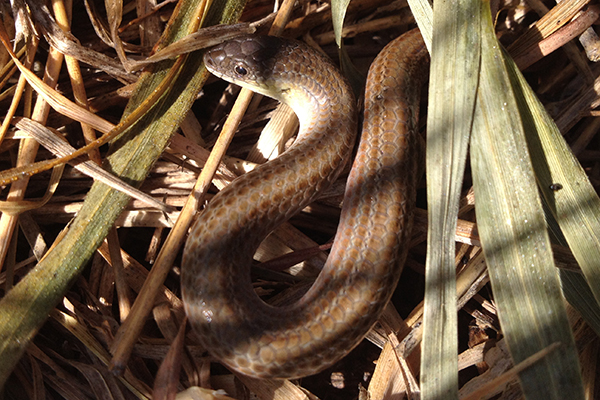Striped Legless Lizard (Delmar impar)
 The native Striped Legless Lizard (Delmar impar) was declared a vulnerable species in the ACT in 1996 and has special protection status. It is listed as vulnerable internationally and nationally and in NSW, and threatened in Victoria.
The native Striped Legless Lizard (Delmar impar) was declared a vulnerable species in the ACT in 1996 and has special protection status. It is listed as vulnerable internationally and nationally and in NSW, and threatened in Victoria.
The species was probably once widespread throughout south-eastern Australia wherever native grassland was present. It is found in the Gungahlin/Belconnen area, the Majura Valley around the Canberra International Airport, in Central Canberra on land adjacent to Yarrumundi Grassland on Lake Burley Griffin, and in the Jerrabomberra Valley. These isolated populations may represent genetically distinct sub-populations. The Gungahlin reserves have some of the largest remaining populations of the species.
The Striped Legless Lizard can live more than seven years and up to 20. It is usually less than 300 millimetres long and weighs 3–4 grams. A pattern of alternate dark and light brown stripes run the length of the body, beginning at the neck and becoming diagonal on the tail. The sides of the face usually have a yellow flush and the eyes have a pale ring of scales around them. When handled, individuals often emit a high-pitched squeak.
This small lizard likes naturally treeless grassland dominated by medium-height native tussock grasses like Kangaroo Grass, wallaby grasses and speargrasses, but is also found in areas of taller grasses and in degraded grasslands dominated by exotic species. They burrow into soil during the late afternoon, re-emerging in the morning and remaining active during the day, including basking in sunshine. Females lay two eggs a year in December–January, sometimes in communal clutches up to 36 eggs. They hatch in January–February. The lizards will eat a broad spectrum of invertebrates, with apparent preference for spiders, crickets, caterpillars and cockroaches.
Conservation threats
Approximately 99.5% of Natural Temperate Grassland in Australia has been destroyed or drastically altered since European settlement.
The major threats to the Striped Legless Lizard are:
- loss and fragmentation of habitat through clearing of native grasslands for urban, industrial and infrastructure development and for agricultural purposes
- modification and degradation of native grassland habitat, particularly through weed invasion, pasture improvement, intense and overgrazing, ploughing, drought and other heavy disturbance
- predation by domestic, wild and native animals
- major ecological disturbances to grassland habitat such as widespread (unplanned) fire, drought and climate change.
Habitat fragmentation and degradation will exacerbate any effects on populations from climate change, which is expected to bring warmer year-round temperatures with fewer frosts, more hot days and warm spells, and declining rainfall (especially in winter). These changes have the potential to affect the lizard's reproduction and survival as the structure of their habitat is sensitive to drought, and sparser ground cover will lead to higher ground temperatures. Reptiles have a limited ability to acclimate to higher temperatures; species close to their heat tolerance limit will be most at risk from climate change. The lizard's limited mobility makes it less able to move to accommodate habitat change.
Conservation actions
Through the Striped Legless Lizard Action Plan (2017), which continues the 2006 action plan, and the ACT Native Grassland Conservation Strategy (2017), the ACT Government proposes to maintain the conditions, in the long term, that encourage a viable, wild population.
The overall conservation objectives include:
- conserve important ACT populations, particularly larger populations that are more robust
- manage the species and its habitat, particularly through mowing or grazing, removal of weeds, patch burning and creation of a diverse habitat structure
- enhance the long-term viability of populations through management of adjacent grassland to increase habitat area and connect populations
- provide offset areas, with management plans, for areas subject to urban development.
- continue extensive survey, monitoring and research
- collaborate with research institutions and non-government organisations and encourage citizen science and volunteers
- encourage responsible pet ownership near reserves, including cat containment.
The highest level of protection is in nature reserves and other areas managed for conservation of the native grassland ecosystem. Where the species occurs on Commonwealth land, the ACT Government will continue to liaise with the Australian Government and Canberra Airport to encourage continued protection and management.
Certain sites will be monitored to determine long-term population trends and to evaluate the effects of management. Research and adaptive management will improve understanding of the species' habitat requirements and techniques to maintain their habitat. It seems that grassland with a mixture of tall and medium height tussock patches linked by areas containing shorter grass and forbs, is likely to provide a greater range of sites for shelter and thermoregulation, and a wider range and/or density of prey.
Current research includes: trialling fire as a tool to manage herbage; and translocating individuals from a proposed development site to potential habitat in NSW and the ACT.
For an improved understanding of the species' biology, ecology, habitat and techniques to breed in captivity, the ACT Government will continue to collaborate with other states, universities, CSIRO, Australian National Botanic Gardens, other research institutions and non-government organisations.
More information
- Australian Government Striped Legless Lizard Conservation Advice
- Australian Government National Recovery Plan for the Striped Legless Lizard (Delma impar) 1999-2003
Contact
Phone Access Canberra on 13 22 81 or email environment@act.gov.au.

